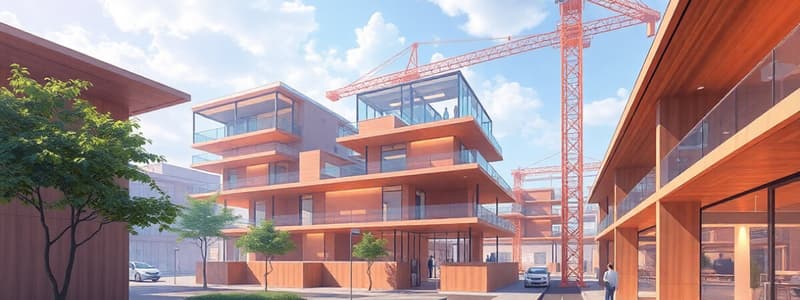Podcast
Questions and Answers
According to the Boston Consulting Group, approximately what percentage could new technologies reduce the average total lifecycle cost of a project?
According to the Boston Consulting Group, approximately what percentage could new technologies reduce the average total lifecycle cost of a project?
Approximately 20%
Provide two examples of how digitization could translate into savings in the construction industry according to the slides.
Provide two examples of how digitization could translate into savings in the construction industry according to the slides.
Digitization could translate into up to $0.5 trillion saving in operation phase, and up to $1.2 trillion saving in Design & Construction phase.
List three examples of data that might be associated with a digital 'door' object in a BIM model.
List three examples of data that might be associated with a digital 'door' object in a BIM model.
Width, height, and material.
Name three concepts related to Building Information Modeling (BIM) that are expected to shape the future of the Architecture, Engineering, and Construction (AEC) industry.
Name three concepts related to Building Information Modeling (BIM) that are expected to shape the future of the Architecture, Engineering, and Construction (AEC) industry.
In the context of Generative Design (GD), briefly explain the relationship between 'Wishes/Requirements,' 'Design,' and 'Solution Space.'
In the context of Generative Design (GD), briefly explain the relationship between 'Wishes/Requirements,' 'Design,' and 'Solution Space.'
What technology does LiDAR use to measure the distance to surfaces?
What technology does LiDAR use to measure the distance to surfaces?
According to Motamedi and Hammad (2013), what type of information can be part of BIM?
According to Motamedi and Hammad (2013), what type of information can be part of BIM?
Besides Building Information Modeling, what are two other types of Information Modeling mentioned?
Besides Building Information Modeling, what are two other types of Information Modeling mentioned?
What can IoT and Cyber-physical systems provide for assets?
What can IoT and Cyber-physical systems provide for assets?
BIM is not just about geometry, what other elements are included?
BIM is not just about geometry, what other elements are included?
What is another name for computational design, based on the slides?
What is another name for computational design, based on the slides?
In the context of design optimization, what four actions are iteratively performed on solutions?
In the context of design optimization, what four actions are iteratively performed on solutions?
According to the slides, what two types of models can be used to optimize the installation of solar panels on a building facade?
According to the slides, what two types of models can be used to optimize the installation of solar panels on a building facade?
In the context of moment-rotation diagrams, what does 'MNm' stand for?
In the context of moment-rotation diagrams, what does 'MNm' stand for?
In the moment-rotation diagram, what does Pu, Pi, Py, and Pc each stand for?
In the moment-rotation diagram, what does Pu, Pi, Py, and Pc each stand for?
What measurement is on the x-axis of the typical moment-rotation diagram?
What measurement is on the x-axis of the typical moment-rotation diagram?
Referring to the 'Predictions' graph, what does $R^2$ represent, and what is its value in this graph?
Referring to the 'Predictions' graph, what does $R^2$ represent, and what is its value in this graph?
What statement does the slide make about the idea of a central model?
What statement does the slide make about the idea of a central model?
In the context of the 'Predictions' graph, what are plotted on the X and Y axis?
In the context of the 'Predictions' graph, what are plotted on the X and Y axis?
What is the significance of 'anchor counts' and 'base diameter' parameters based on the slides?
What is the significance of 'anchor counts' and 'base diameter' parameters based on the slides?
Flashcards
BIM
BIM
Building Information Modeling; a digital representation of physical and functional characteristics of a facility.
Generative Design
Generative Design
An algorithmic design process that produces optimized forms based on defined parameters and constraints.
Lifecycle Cost
Lifecycle Cost
The total cost of ownership over the life of an asset, including initial purchase, operation, maintenance, and disposal costs.
Digital Twin
Digital Twin
Signup and view all the flashcards
Scan to BIM
Scan to BIM
Signup and view all the flashcards
LiDAR
LiDAR
Signup and view all the flashcards
Point Cloud
Point Cloud
Signup and view all the flashcards
COBie
COBie
Signup and view all the flashcards
IM-GIS Integration
IM-GIS Integration
Signup and view all the flashcards
IoT in Asset Lifecycle
IoT in Asset Lifecycle
Signup and view all the flashcards
Design Parametrization
Design Parametrization
Signup and view all the flashcards
Computational Design
Computational Design
Signup and view all the flashcards
Design Optimization
Design Optimization
Signup and view all the flashcards
Solar Panel Optimization
Solar Panel Optimization
Signup and view all the flashcards
Moment-Rotation Diagram
Moment-Rotation Diagram
Signup and view all the flashcards
Anchor Counts
Anchor Counts
Signup and view all the flashcards
Base Diameter
Base Diameter
Signup and view all the flashcards
Failure Moment
Failure Moment
Signup and view all the flashcards
Central Model Myth
Central Model Myth
Signup and view all the flashcards
Study Notes
Digital Technologies in Design
- Digital technologies are transforming the design process, showing potential to significantly reduce project costs and improve efficiency.
- The average lifecycle cost of a project can potentially be reduced by almost 20% with new technologies.
- Digitization could translate into $0.5 trillion in operational phase savings, and up to $1.2 trillion in design and construction phase savings.
- Digital technologies are not equally implemented across sectors. Sectors like ICT, media, and finance/insurance have higher digitization levels compared to healthcare, construction, and hospitality.
- Current levels of digitization in different sectors vary considerably.
Lackluster Performance in Construction Projects
- Construction projects frequently experience significant overruns in capital expenditure, often exceeding the originally quoted amount.
- The average delay beyond the original schedule for mining projects is 20 months.
- Infrastructure projects tend to have an average overrun of 80%.
- Oil and gas projects commonly show a similar pattern of delays and cost overruns.
Do We Improve?
- The execution of construction work has not seen significant improvement over the last 50 years, according to John M. Beck.
- The gross value-added in the United States shows no consistent improvement across different sectors (agriculture, manufacturing, wholesaling/retail, and construction) for the period 1947 to 2000.
R&D Spending
- Research and development (R&D) spending in construction is significantly low, less than 1% annually.
BIM Evolution: Exponential Growth
- BIM has evolved since the 2000s, moving through stages of design coordination, two-track integration, and now towards integrated systems and AI.
- BIM 1.0 characterized by design coordination and clash detection.
- BIM 2.0 marks a step towards integration and full use across multiple sectors (structural, complex façade engineering, site-model synchronization).
- BIM 3.0 and 4.0 move towards lean BIM, automation, and 3D printing.
- BIM 5.0 explores smart city integration and AI enhancements, "connected BIM" and data-driven decision making throughout the project lifecycle.
Research Trends in BIM: Generative Design
- Generative design explores numerous solutions based on given parameters and constraints.
- The process involves creating, evaluating, identifying the best, and evolving the solutions until they meet the required objectives.
- Generative design can improve productivity, enhance collaboration, and create significant buzz.
- Key goals during generative design include adjacency preferences, low distraction workspace, optimal views, and ease of connectivity within the built environment.
Research Trends in BIM: Parametric Design
- Parametric design is a key precursor to generative design when introducing design parameters and constraints.
- The process identifies the variables, their relationships, and develops parametric models to define the building's parameters.
- The current limitations of BIM tools in supporting generative design were also noted.
Research Trends in BIM: Scan-to-BIM
- LiDAR technology measures distances to surfaces based on time-of-flight.
- Point clouds are created to generate BIM models.
- This technology allows for the creation of BIM models for existing structures based on 3D scanning.
- Process involves transforming points clouds into an accurate digital model by detecting walls, creating navigation graphs, subdividing spaces, and modifying walls and rooms.
Research Trends in BIM: Lifecycle Support
- COBie (Construction Operations Building Information Exchange) data format facilitates the collection of information of all assets in a building throughout its lifecycle.
- Data on assets like equipment and their lifecycle characteristics (manufacturing date, installation date, last maintenance, repair history, and next scheduled maintenance) significantly supports asset management.
Research Trends in BIM: Infrastructure Modeling
- BIM can extend to infrastructure modeling, encompassing road, bridge, and utility information.
- A single or network level of representation can optimize infrastructure BIM models.
Research Trends in BIM: Digital Twin
- Digital twins represent a close integration between the virtual and physical worlds.
- Data from the physical world are used to refine the virtual model.
- Real-time operational data, what-if analyses, and predictive maintenance are part of this digital twin approach.
Research Trends in BIM: BIM and Modular Construction
- Modular construction uses BIM to model, plan, manufacture, package, and deliver elements of the structure.
- Using production plans, rooms are tagged using BIM to facilitate delivery.
Research Trends in BIM: Virtual Construction
- Virtual construction uses BIM to simulate the construction process with regards to geometry, time, motions, safety, and other parameters.
Requirements for Successful BIM Implementation
- Successful BIM implementation requires strategic considerations, encompassing people, process, and technology.
- Knowledge and technology accumulation is a crucial factor, achieved through strategic steps during BIM adoption.
BIM Roadmap
- Stages of BIM evolution have been identified, ranging from early coordination and communication BIM to more advanced integration, lean, AI BIM and beyond.
Quotes
- Thomas Watson of IBM believed that a world market exists for perhaps only five computers (1943).
Studying That Suits You
Use AI to generate personalized quizzes and flashcards to suit your learning preferences.




